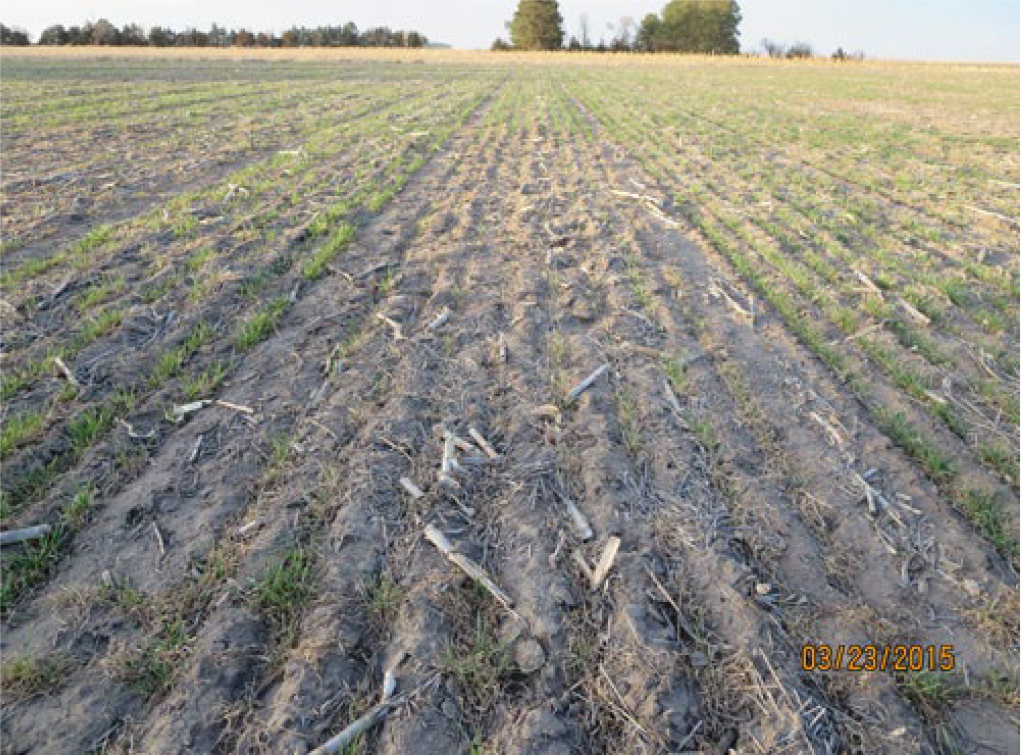⇦ Back to Crop Management Home
¶ Introduction
Winter injury or “winterkill” often occurs when wheat plants are under drought stress before freeze-up and there is little snow cover during the following months. Such plants have little tillering and poorly developed root systems. Late planted dryland wheat fields are often most susceptible to winterkill. Varieties differ in their ability to tolerate winter injury.
Winterkill occurs during dormancy when the crown is damaged by freezing conditions. Wheat is most vulnerable when temperatures drop to single digits for an extended period. Injured crowns may have enough nutrients to green up later, but have vascular damage so nutrients cannot move within the plant. Root rots often move in to kill plants.
Winterkill reduces yields by killing tillers or killing whole plants. This later reduces the number of heads per acre which leads to lower yields. If winter injury is severe enough, entire fields or parts of fields may have to be destroyed or replanted.
Freeze damage occurs later in the season and differs from winterkill. Freeze injury occurs after wheat has broken dormancy and has started jointing.
¶ Testing for Winter Injury
A simple test using a plastic bag can be used to find if winter wheat plants are still alive, even if they are dormant. The test can help wheat producers evaluate the health of the crown, the plant, and the tillers.
The test involves removing the winter wheat crowns from the soil, rinsing, and growing them in plastic bags. After a week, the crowns are examined to identify the number of live plants and tillers. Several individual samples may be needed across a field because winter injury can vary across the field depending on soil type, slope, and other factors.
¶ Figure 1. Wheat Variety Differences

(https://cropwatch.unl.edu/2015-wheat-winterkill)
¶ Sample Preparation
1. Use a spade or trowel to remove the top three inches of soil that contains the wheat crown and roots.
2. Thaw samples and warm them slowly to room temperature.
3. Carefully remove the soil from the roots and use cool water to wash away the remaining soil.
4. Cut leaves 1½ inches above the crown. Cut roots just below the crown
5. Place five wet crowns in a labeled two-quart plastic freezer bag. Inflate the bag to one quart or larger. Tie or close the bag.
6. Place the bags in a lighted room, but not in direct sunlight.
After two days:
7. Check crowns and rinse with cool tap water.
8. Reinflate bag and close.
After four days:
9. Check crowns. Live crowns should show ½-inch or more new growth.
After six days:
10. Check crowns. Crowns that are not growing should be assumed to be dead in estimating plant survival. Crowns that do not grow, or grow poorly, may appear moldy. These molds are generally the saprophytic type, those that live on dead plant material.
Some plants may have one tiller that survives while the other tillers have been winter killed. Such a plant has lost most of its vigor and much of its yield potential even though it is alive.
¶ References
“Winter wheat hurt by lack of moisture”. Farm & Ranch News press release. Coop. Ext. Svc., SDSU, Brookings SD. 1987
BeanDuncan. Winterkill of wheat. AgriLIFE Extension news release. TAEX, Texas A&M, College Station. Feb. 2011.